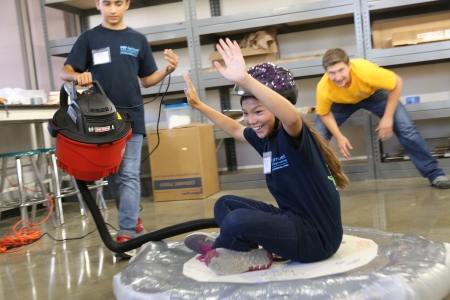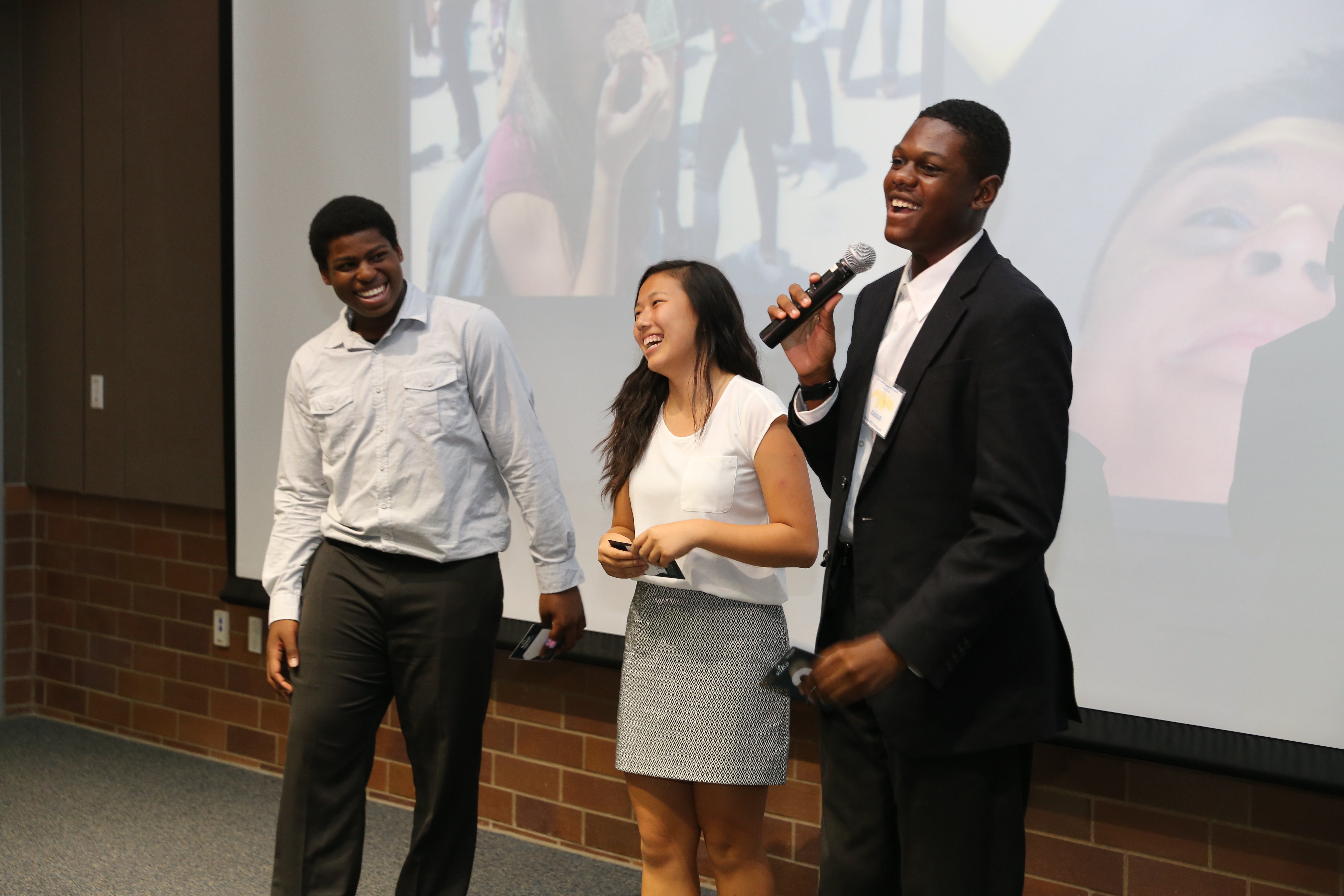Summer STEM Learning Thrives at Samueli School
FABcampers ride their homemade vacuum-powered hovercrafts.
“We need to encourage kids to be creators and not just consumers of technology,” explained Leyla Riley, director of academic innovation, partnerships. “Now more than ever, the tools needed to design and build just about anything are becoming more affordable, accessible and easier to use. Our outreach programs emphasize learning by doing and use differentiated learning experiences, building on specific or situational interests. This is an excellent way to engage kids in science, technology, engineering and mathematics (STEM).”
FABcampers have fun while learning
The teenagers started arriving in June. Six weekly sessions of FABcamp attracted a total of 163 middle schoolers for a busy five days of hands-on learning, demonstrations and lab tours.
Now in its fourth year, the Samueli School’s popular summer engineering camp introduces students to different engineering disciplines through projects that emphasize science, technology, engineering and mathematics (STEM) concepts. Campers work in teams on specific engineering design challenges and receive instruction in computer-aided design, rapid prototyping and fabrication technologies.
“All of our activities emphasize 21st century skills such as critical thinking, communication and problem solving,” said Riley, adding that female participation rates increased by over 50 percent since last summer. “And thanks to the generous support of the Nicholas Endowment and the Broadcom Foundation, 60 scholarships were awarded to low-income families.”
Campers designed and made their own balsa-wood airplanes, cast plaster models of their thumbs, learned how to build basic circuits and created LED display boards. They constructed index card structures and strength-tested them with bricks. They made hand-shaken vanilla ice cream, learned how to create a fuel cell and put together a simulation prosthetic heart valve using thin plastic, pipe cleaners, modeling clay, duct tape and a Styrofoam ball. On the final day of camp, they built a vacuum-powered hovercraft, then took turns riding it.
“Best summer ever,” said one FABcamper on his last day.
ASPIRE and INSPIRE reach high school and community college students
The ca High school students present their team project called Pulse.
This was the second year of the ASPIRE and INSPIRE programs. Targeting high school and community college students, the programs leverage UCI’s engineering and computer science facilities and participating faculty and students for a two-week summer course. Working in classrooms and maker-spaces, students learn skills across the broad spectrum of engineering and computer science disciplines. Supervised by faculty and taught by experienced staff and graduate mentors, the program includes guest speakers and lab tours, as well as hands-on fabrication, coding and design activities.
Thanks to funding from the Broadcom Foundation, this year’s students were able to stay in the on-campus residential halls for two weeks. Sharnnia Artis, assistant dean of access and inclusion, said it was an opportunity for kids to learn how to manage their time and to experience what it is like to live on campus. “These students have been working so hard, I had to kick them out of the lab the last night,” she said.
A panel of faculty judges joined parents and relatives in the auditorium to hear students from 17 high schools and nine community colleges pitch their ideas. Working in teams of three, the students had selected their projects from a list of 15 ideas. There were 10 teams in total, and all projects took on a problem to solve. The high school students’ winning project was Pulse, a wearable device that matches the wearer’s heart rate to a color, providing a quick, accurate reading to EMTs, athletes and everyday consumers who use the device as tech wear. The community college overall winner was Touch of Life, a medic alert-type device worn on the fingertip that does not require power. A solar-powered lawn mower was deemed the most complex, and a mobile home-security system called Rolley Police earned the People’s Choice award.
For student Kasia Sayles, the best part of the week was the hands-on activities because they gave her confidence. Her team project, InfinEX, was a smart portable translator that can be carried on a keychain. “I worked on a Raspberry Pi and discovered I was a quick learner,” said the Chaffey College student, who hopes to transfer to UCI this fall.
“This program shows that if you select smart students, give them the right resources and guidance, they can do amazing things,” said Associate Professor Ahmed Eltawil, who along with Professor Fadi Kurdahi serves as faculty adviser.
Artis encouraged the student to continue pursuing their interests in STEM. “Remember, this is just a start. Engineering and computer science are great places for your talents.”
First UCI Base 11 students build drones
Five community college students participate in the UCI Base 11 summer fellowships.
The students in the Autonomous Systems Engineering Academy lived on campus while working on their projects, and received a stipend. “I learned more about myself and how I work with a team,” said Alex Hercules, a student from Skyline College in the Bay Area. “The experience definitely changes you.”
Hercules and his teammates, Thong Vo from Grossmont College and Fakhirah Mohd Khairuddin from Orange Coast College, developed a quadcopter with the idea that it would be to education what “Big Hero 6’s” Baymax is to healthcare.
On the other team, Henry Ford College students Will O’Connell and Huda Sedaki designed and built an unmanned autonomous system that would alert drivers to hazards ahead on freeways, to help prevent huge pileups like those in their home state of Michigan.
Under the mentorship of UCI graduate student Verenice Mojica, the students learned SolidWorks software to design their drones, and then used the equipment in FabWorks and RapidTech -- which Base 11 helped refurbish -- to build them. “The coolest thing I experienced was access to the facilities,” said Vo. “There are so many amazing tools that I can use.”
The summer fellowship is one component of a partnership Base 11 and the Samueli School forged earlier this year, which also includes an academic-year internship program for local community college students and a STEM Entrepreneur training program.
“UC Irvine is an ideal partner for Base 11 because of our shared vision to increase access and opportunities for underserved students in STEM fields,” said Landon Taylor, CEO of Base 11. “Together, we can close the talent gap in STEM and prepare the next generation of STEM leaders.”
For more information or to apply for the Base 11 programs at UCI, visit: http://www.base11.com/programs/fellowships/
